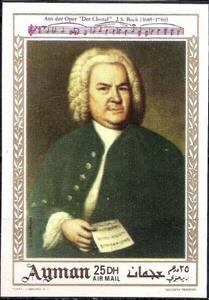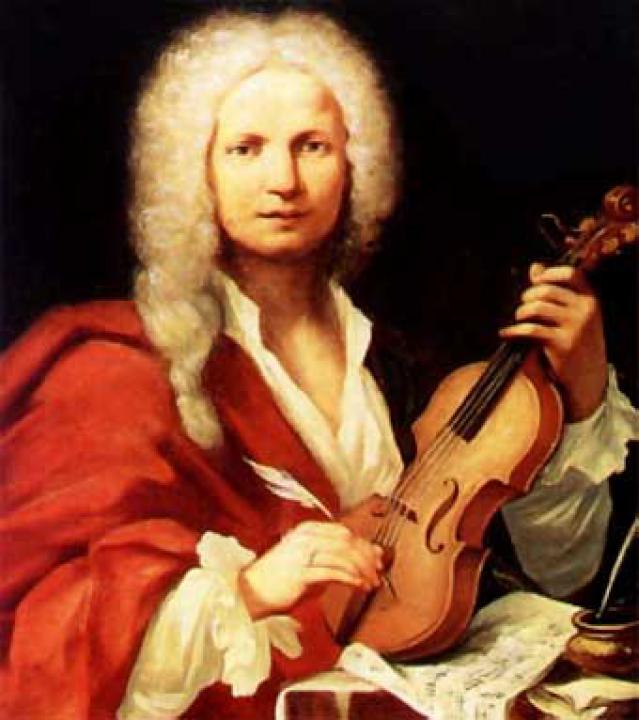Stamp: Johann Sebastian Bach (1685-1750) (Ajman 1969)
Johann Sebastian Bach (1685-1750) (Ajman 1969)
01 March (Ajman ) within release Paintings: Composers goes into circulation Stamp Johann Sebastian Bach (1685-1750) face value 25 United Arab Emirates dirham
| Stamp Johann Sebastian Bach (1685-1750) in catalogues | |
|---|---|
| Michel: | Mi: AJ 427B |
Stamp is vertical format.
Printed in sheets of 6 (3x2)Also in the issue Paintings: Composers:
- Stamp - Vincenzo Bellini (1801-1835) face value 5;
- Stamp - Franz Liszt (1811-1886) face value 10;
- Stamp - Johann Sebastian Bach (1685-1750) face value 25;
- Stamp - Georges Bizet (1838-1875) face value 10;
- Souvenir Sheet - Johann Sebastian Bach (1685-1750) face value 25;
- Souvenir Sheet - Vincenzo Bellini (1801-1835) face value 5;
- Souvenir Sheet - Wolfgang Amadeus Mozart face value 12;
- Stamp - Wolfgang Amadeus Mozart face value 12;
- Souvenir Sheet - Georges Bizet (1838-1875) face value 10;
- Souvenir Sheet - Vincenzo Bellini (1801-1835) face value 10;
- Stamp - Franz Liszt (1811-1886) face value 10;
- Stamp - Georges Bizet (1838-1875) face value 10;
- Stamp - Johann Sebastian Bach (1685-1750) face value 25;
- Stamp - Vincenzo Bellini (1801-1835) face value 5;
- Souvenir Sheet - Wolfgang Amadeus Mozart face value 12;
- Full Pane - Franz Liszt (1811-1886) face value 6*10;
- Full Pane - Franz Liszt (1811-1886) face value 6*10;
- Full Pane - Johann Sebastian Bach (1685-1750) face value 6*25;
- Full Pane - Johann Sebastian Bach (1685-1750) face value 6*25;
- Full Pane - Vincenzo Bellini (1801-1835) face value 6*5;
- Full Pane - Vincenzo Bellini (1801-1835) face value 6*5;
- Full Pane - Georges Bizet (1838-1875) face value 6*10;
- Full Pane - Georges Bizet (1838-1875) face value 6*10;
Stamp Johann Sebastian Bach (1685-1750) it reflects the thematic directions:
An artist is a person engaged in an activity related to creating art, practicing the arts, or demonstrating an art. The common usage in both everyday speech and academic discourse refers to a practitioner in the visual arts only. However, the term is also often used in the entertainment business, especially in a business context, for musicians and other performers (although less often for actors). "Artiste" (French for artist) is a variant used in English in this context, but this use has become rare. The use of the term "artist" to describe writers is valid, but less common, and mostly restricted to contexts such as critics' reviews.
A composer is a person who writes music. The term is especially used to indicate composers of Western classical music, or those who are composers by occupation. Many composers are, or were, also skilled performers of music.
Painting is the practice of applying paint, pigment, color or other medium to a solid surface (support base). The medium is commonly applied to the base with a brush, but other implements, such as knives, sponges, and airbrushes, can be used. Painting is a mode of creative expression, and the forms are numerous. Drawing, gesture (as in gestural painting), composition, narration (as in narrative art), or abstraction (as in abstract art), among other aesthetic modes, may serve to manifest the expressive and conceptual intention of the practitioner. Paintings can be naturalistic and representational (as in a still life or landscape painting), photographic, abstract, narrative, symbolistic (as in Symbolist art), emotive (as in Expressionism), or political in nature (as in Artivism). A portion of the history of painting in both Eastern and Western art is dominated by spiritual motifs and ideas. Examples of this kind of painting range from artwork depicting mythological figures on pottery, to Biblical scenes rendered on the interior walls and ceiling of the Sistine Chapel, to scenes from the life of Buddha or other images of Eastern religious origin. In art, the term painting describes both the act and the result of the action. The support for paintings includes such surfaces as walls, paper, canvas, wood, glass, lacquer, clay, leaf, copper and concrete, and the painting may incorporate multiple other materials including sand, clay, paper, plaster, gold leaf, as well as objects. The term painting is also used outside of art as a common trade among craftsmen and builders.



